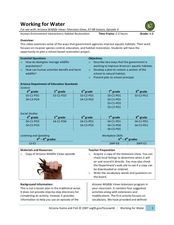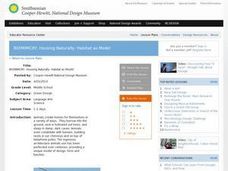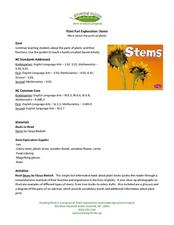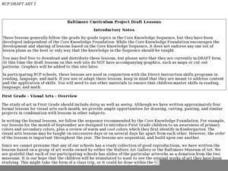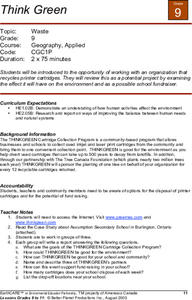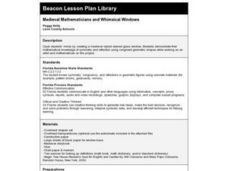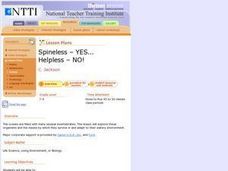Curated OER
Human Footprint
Students study facts about humans and how they are impacting the Earth. In this investigative lesson plan students help map peoples footprints over the Earth's surface and evaluate these factors.
Curated OER
Working for Water
Students examine the ways that government works to help improve aquatic habitats. In this water habitats lesson plan students view a video and plan a school restoration project.
Curated OER
Taxonomy
Students analyze the complexity of organism classifications based on certain criteria. In this classifying organisms lesson students study taxonomy and gather information and leaves to do their own experiment on classification.
Curated OER
Similar Triangles - Applied Problems
Young scholars differentiate between similar and congruent triangles. In this geometry lesson, students identify the angles of triangles using the similarity theorem. They apply concepts of triangles to the real world.
Curated OER
BIOMIMICRY, Housing Naturally: Habitat as Model
Students explore natural animal habitats. In this lesson on biomimicry and habitation design, students will use classroom and field examples to examine animal habitats. Students will construct a model of a natural animal habitat. This...
Curated OER
Habitats of the World
Students complete a unit of eighteen lessons that cover climate, geography, location, plants, and animals of each of the five habitats. They are also introduced to habitat destruction and discuss ways to protect the environment. They do...
Curated OER
Walden the Ballad of Thoreau
Students role play to become familiar with the life of Thoreau. In this Thoreau lesson, students view a video of the Walden play about Thoreau. Students perform and promote the play as a school event.
TerraCycle
What Can Nature Teach Us about Sustainable Design?
Talk about Velcro®, Gecko Tape, WhalePower turbine blades, and other innovations that mimic nature to inspire your STEM or engineering class. This set of worksheets gets them thinking about imitating nature in terms of sustainable...
Curated OER
Plant Part Exploration: Stems
Explore water transport in plant stems using this fun experiment! Your scientists will start by reading Stems by Vijaya Bodach. Then, activate prior knowledge about plant stem functions and water transportation....
Curated OER
Visual Art: Primary Colors
First graders identify primary colors and consider their use in works by Henri Mattise and Mary Cassatt. They conduct an experiment with food coloring and then draw a color tree differentiating between warm and cool colors.
Curated OER
Narrow Road to the Interior
Students investigate the life and work of the Japanese poet, Matsuo Basho as the Japanese poetic forms are studied. Nature, symbolism, and history are probed as the lesson is developed.
Curated OER
A Walk in the Woods
Students observe an environment, ask questions about what they observe. and design experiments to answer one question they came up with in this upper-level High School or college lesson. The lesson requires an outdoor exploration or...
Curated OER
Finding and Measuring What You Can't See
Learners determine how scientists measure pollutants in food and the environment. Students discover how scientists remove one material based on its physical properties. Learners figure out how much of a pollutant is present after...
Curated OER
SIRS Discoverer - Narrowing a Search
Students discover how to obtain precise information during an internet search. They work in pairs to develop skills in using SIRS Discoverer to find an article on a specific topic. They evaluate the article on relevance to the topic...
Curated OER
Think Green
THINKGREEN has a computer printer cartridge collection program. After reading the story of how Assumption Secondary School in Burlington, Ontario started participating in the THINKGREEN recycling program, pupils work in groups of...
Curated OER
Medieval Mathematicians and Whimsical Windows
Third graders demonstrate their mathematical knowledge of symmetry and reflection using congruent geometric shapes while working as an artist and mathematician looking at a medieval-styled stained glass window.
Curated OER
Spineless - YES... Helpless - NO!
Young scholars distinguish between invertebrate and vertebrate organisms while examining the zoological classes of a number of invertebrates. They illustrate a food web of these organisms and investigate the impact of humans on the...
Curated OER
This Place is Going to the Dogs
Students study different breeds of dogs. They watch a video, "Extraordinary Dogs", about special dogs and how they are categorized according to their adaptations. Then they create a digital video that demonstrates the qualities of dogs...
Curated OER
Classifying Conundrum
Fourth graders identify plant characteristics from different environments and communicate that information in different ways. They use a simple scheme to classify Utah plants and animals and make observations and record them in a...
Curated OER
Creative and Cultural Dance
Learners study dance as a way to communicate and represent oneself in the world. They perform and articulate movement skills from the "dancer's toolbox". They solve problems in dance using the "dancer's toolbox" composing, witnessing,...
Curated OER
Who Were the Mayans?
For this Mayans worksheet, students read about the Mayans on a web site given, then complete a set of 10 related comprehension questions.
Curated OER
Making Connections, Linking Population and the Environment
Students find out that all habitats have a carrying capacity. They explore how the world's human population has grown markedly in the 20th century, and that humans impact environmental health. Students investigate that people can and...
Curated OER
Send Me A Postcard From The Rainforest
Learners research the different regions of the rainforest by using the Internet. They create their own postcards from each region they examine showing the plants and animals of that region. They share their postcards with the class.
Curated OER
Side by Side: Butterfly Wings and Symmetry
Students observe butterfly images and then draw and paint their own design. They use this activity to explain symmetry.



